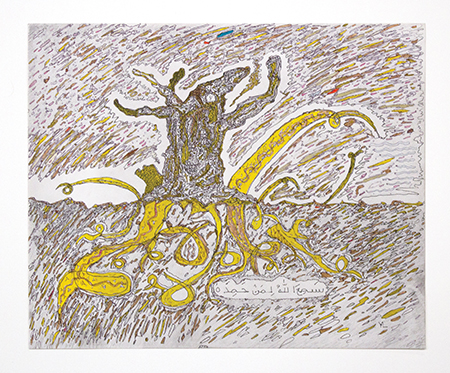Yusef Lateef

In 1970, when asked the question: ‘What is jazz?’ Louis Armstrong reportedly replied: ‘If you have to ask, you’ll never know.’ In his essay, ‘Perennial Fashion – Jazz’ (1967), German theorist Theodor Adorno characterized the form as the ‘false liquidation of art’, identified by a ‘eunuchlike [sic] sound’, and ‘castration symbolism’. Apparently, Adorno didn’t get it.
Around the same time, artist, musician, and professor Yusef Lateef was asked by the Dean of the Manhattan School of Music, where Lateef was earning his master’s degree, to research the term ‘jazz’. What he discovered was an attendant list of definitions that included cultural references from the not-so-distant Jim Crow days: ‘skullduggery’, ‘tom-foolery’, and ‘to copulate’, among them. For Lateef (nicknamed ‘Teefski’ or ‘Teefi’ by his band mates) – who had played tenor sax for Dizzy Gillespie just out of high-school in 1949, toured with the likes of Hot Lips Page and Roy Eldridge, and would go on to record several dozen albums with storied labels Impulse! and Atlantic, as well as win a Grammy award in 1987 – the word ‘jazz’ became a misnomer, a term, he would proclaim, ‘that has nothing to do with the music’. In it’s place, Lateef chose to describe his musical works as ‘autophysiopsychic’, a Platonically inspired neologism that located the genesis and experience of music within the ‘physical, mental and spiritual spheres’.
As curator Alhena Katsof demonstrated in an exhibition of Lateef’s drawings and graphic notations at White Columns, the musician’s avant-garde practices extended far beyond the recordings for which he was better known. Among the works on paper, Untitled (all works undated), depicts an earth-toned, stump-like form with vibrant yellow roots probing beneath the surface as well as protruding from it. In the lower right-hand corner of the image, a text bubble surrounds an inscription in Arabic. For Lateef, who converted to the Ahmadiyya sect of Islam in the late 1950s, his faith and art were closely intertwined. His conversion was no doubt one of the reasons he chose to stop performing in venues where alcohol was sold, among them nightclubs.
In Elsewhere Plants, a triad of intricately detailed abstract forms, Lateef’s interest in compositional improvisation is apparent. Influenced by Arnold Schoenberg, Lateef’s musical scores often embraced a dissonance evoked by instrumental asynchronism and use of tempo intervals. Similarly, Lateef’s drawings relied on a mix of automatic drawing and contingency that recalls André Masson’s surrealist-inspired techniques, as well as Joan Miró’s works on paper. And, like Miró, Lateef’s abstract forms, as with his Trees, have a distinctly organic feel to them, with spindly tendrils and amoeba-like shapes populating his compositions. Similarly, Decadence – a dense network of connecting lines, geometric shapes, cell-like structures and sinuous forms – gives the sense of peering into a microscope, albeit in a decidedly altered state.
Lateef produced the majority of his drawing in the same studio in which he recorded and several of the works in the exhibition collapsed the boundary between his musical and artistic practices. As with Untitled, a chaotic cloud of vibrant orange, red and yellow-hued watercolours, as well as pen and pencil illustrations, Lateef introduces black ink into the composition by pouring small puddles onto the works’ surfaces, which he subsequently spreads out by blowing through a straw. In the fanned rivulets of ink that creep across the paper, Lateef, quite literally, transforms the image into a musical act. Lateef’s drawings are music for the eyes.















